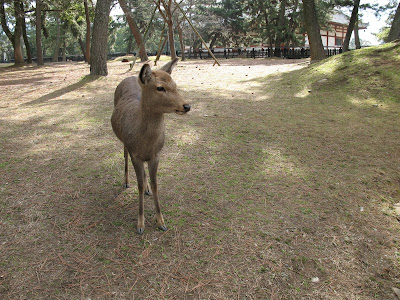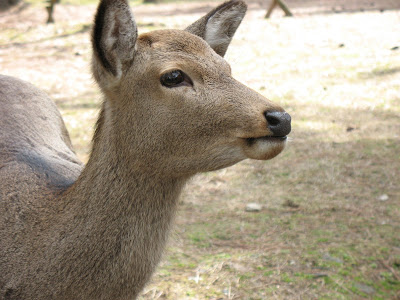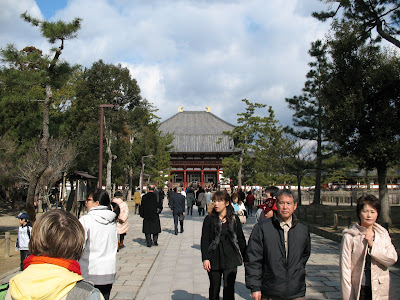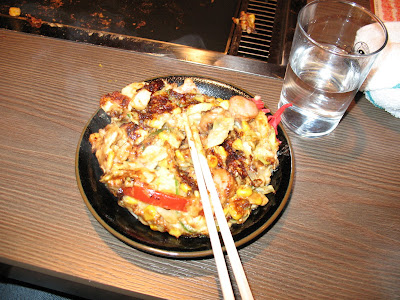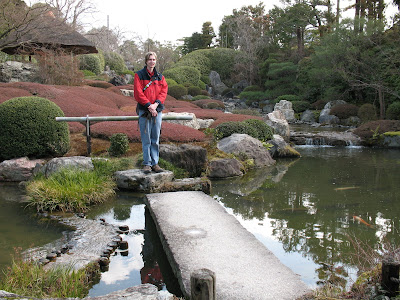It has been some time, so there is much to catch up.
Well, on the Friday before last (that’d be about February 16), I went down to Osaka with my friend Kara to hit up Shinsaibashi, which is one of the big shopping districts of Osaka. Now, I have mentioned before that I don’t have the taste for such things, but I, too, get a little starry eyed at the sight of neon lights and was looking for a change of pace from the temples, so this seemed like the prime spot for such aimless wandering.

America Mura at dusk
We left after classes and got there about mid-afternoon, in time to roam a bit in daylight. We started off in America Mura, which I suppose is analogous to Chinatown in New York, except this was America Town in Japan. I’m not sure though, it didn’t seem particularly different from other places… just filled with a bunch of shops selling Levi’s Jeans, Abercrombie and Fitch, and the obligatory McDonalds (but those are everywhere here, and I mean everywhere, along with Starbucks). They did have a miniature Statue of Liberty, though. And then atop another building was a flashing neon sign that called on people to “Stop AIDS!” through the use of condoms. This seemed rather peculiar, but what would seem unusual mediums for communication here are fairly typical.
For example, political candidates will have vans with loudspeakers that drive around the city while someone touts the candidate over the PA. Now I have no idea when the next election is in this country, and it may not even be soon, but they’re out there campaigning nonetheless. And why being obnoxious would win candidates votes, especially in a place that seems to appreciate quiet so much, is beyond me.
Also, it is quite common when exiting a subway or train station to walk by a person handing out small packs of tissues. This is convenient not simply because it is the cold-season, but also because many public restrooms here do not have toilet paper. But tucked away in each tissue pack are advertisements. It’s a win-win situation – people get tissues, the companies get advertising that won’t be chucked at the next available public wastebasket (though those, too, are rare here). So I suppose if there’s going to be a neon light sign telling people to use condoms, Japan would be the place for it.
After quickly passing America Mura, we wandered a bit further and found the Apple Store in Osaka. It looks neat from the outside, but it’s really no different than any other Apple store in the world.


And then we came across a giant covered mall in the area. Also close by were restaurants that serve that Japanese delicacy of pufferfish which must be cut and prepared the right way or else you will die. Yes, die. It sounds a bit risky, but no one has died for more than 30 years from it, so perhaps it’s not so bad. Either way, I’m still not lining up to try it.





We wandered a bit and found a street that began with restaurants and ended with love hotels. Now love hotels are a bit of an oddity. They are hotels that are made for couples to well, “spend time together.” People can either rent rooms for the night or for a three hour “rest.” I am honestly not sure what to think of these. On the one hand, it strikes me as being almost sleazy. But then again, Japan is a highly populated area with small houses and apartments spaced close together (and often with thin walls without insulation). This means that people aren’t afforded much in the way of privacy (this is also why it’s rude to be walking the streets at night making much more than a whisper… because people inside can usually hear just about everything going on outside). Also because space is limited, there are many lounges in Japan that simply provide people with a space to play pool, read manga, surf the internet and generally hang out with friends for some amount of money per hour. This would also seem to be in response to the lack of space in homes for say, hanging out with friends in relative privacy from parents, neighbors, siblings, etc. Given all this, it would almost seem that the love hotel concept is born out of a kind of need (and I won’t make any comment on the value of such a need) that seems legit, but that didn’t make it feel any less strange to mine American eyes.
We stopped for some food here and there and continued walking, and this time, we really hit the gutter. We found ourselves on a street of host and hostess bars. These are essentially bars where women (though there are host bars that do the opposite) are dolled up and paid to flirt with men while they drink and whatnot. I don’t know if that sounds as bad as it looked, but it wasn’t good. We snapped a few pictures of the area for laughs and headed out quickly, before all daylight vanished.
And then we were back in the main plaza, where everything was lit up like the fourth of July.

It was a fun stroll through a part of Osaka we hadn’t seen, but we were getting tired so we met up with Daniel (who had unsuccessfully tried to visit Osaka Castle that afternoon) and went to an Izakaya near Makino and just sat around and hung out for the evening.
Saturday was rainy, very, very rainy. And cold. But I had signed up to learn to roll sushi, and I wasn’t about to let the rain stop me. So I went to campus and met the group. But, unfortunately, it wasn’t so much rolling sushi (with a bamboo roller or some such thing), so much as it was stuff as much stuff as you can on seaweed and rice and roll it and eat it like a sandwich. I was a bit disappointed, but, as John Lennon would say, “Ooh ba dee, Ooh ba daa, life goes on.”
I had made plans with Daniel and Kara to meet them and the Swedes and some others for karaoke Saturday night, but when we got to the karaoke place, it was much more expensive than we had anticipated and we were all a bit drained from the weather, so Kara, Daniel and I headed off to grab dinner (I haven’t done karaoke yet, but don’t worry, maybe this next weekend). We wandered around in a bookstore after dinner to see if the karaoke people wanted to do something when they were finished, but they weren’t interested so the three of headed up to the izakaya across from campus where we had originally gone. Here we found that the guy who waited on us was also a Gaidai student studying English. We invited him to join us at our table and we talked for a while with him. He’s probably the most fluent Japanese student we’ve met in terms of pronunciation and naturalness of speech, which he explained is because he spent his elementary school years in the United States.

Daniel, again unable to just smile

Super Happy Kara and "Blue Steel" Evan
That Sunday, I didn’t do too much. I mostly took the day to relax, shower, and piddle around the dorm. It was good to relax.
Monday, after classes, Daniel and I headed to Kyoto to go to the Joanna Newsom concert. Now, if you are unfamiliar with Joanna Newsom, she is an American artist who plays the harp and sings. She has quite an unusual voice, and many people are put off by it, but it is truly beautiful. The concert took place on the third floor a building in what appeared to be a loft apartment converted into a bar/hipster hangout. It was a very nice venue, but also super chic. I’m talking people wearing thick rimmed glasses on their noses and high brow opinions on their sleeves. But I’m judging too much, but it had that vibe to it (at least among some of the non-Japanese there).
But, after the two openers (one of which was a Japanese couple that played great music on an accordion and upright bass), Joanna Newsom and her two person band came on. After a set that lasted a bit over an hour plus an encore, Daniel and I rode the train back home smiling and resting in the resonance of the divine music we had just heard. It was an amazing concert, and certainly one of the best I have been to. I even have a little video from the concert for you:
"Peach, Plum, Pear"
"This Side of the Blue"
The rest of the week was school as usual. I’m finding my classes here are pretty lax. Japanese is great and fun, but not too much trouble. Sumi-e is mostly an in-class affair, so I don’t have to worry with it outside of our thrice weekly 90 minute meetings. And Death in East Asian thought is generally a disappointment, but it’s easy enough, and that I am glad about because I’d much rather be out enjoying Japan and seeing it first hand than sitting in my dorm reading about it.
This past weekend, I went to eat Chinese food with Kara on Friday night and then just chilled on my own that evening. I’ve begun making plans for Spring Break, and I’m getting pretty excited about. My plan right now is to go to Tokyo for a few days before heading to the Izu Peninsula (a little ways outside of Tokyo south of Fuji) which is known for its beautiful coastline and many onsen (hot spring baths). So I’ll have a taste of the quick and fast-paced Tokyo life along with time for taking things slow and relaxing at Izu. While in the area, I also want to try to make it up to Mt. Fuji to get a few good views of the mountain. It’s too cold to climb (ice and snow and dangerous conditions) until July, so I’ll have to forego that, but it should still be fun.
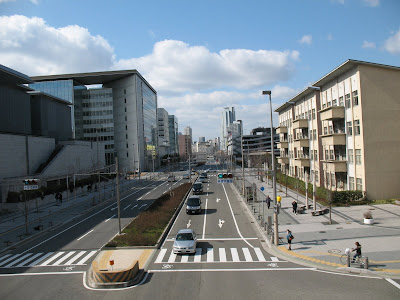
Kobe

Earthquake Museum
But anyhow, on Saturday Kara and I met up early and headed towards Kobe (yes the “Kobe beef” Kobe), which is west of Osaka by maybe 20 km. Our first stop was at a strange museum. Well, I say strange, but really only one half of it was unusual. The first half was about the Kobe Earthquake which occurred early in the morning on January 17, 1995. It was a 7.0 on the richter scale and after seeing the opening presentation which simulates the images and sounds of the Earthquake, any small desire I may have had for a little tremor while here vanished (we have been fortunate to not experience any noticeable earthquakes or tremors thus far). It seemed to be truly frightening. What was most interesting about the museum was a volunteer who guided us through and told us stories about the earthquake, including a man who had woken a few minutes before the quake and noticed his cat was freaking out. Then, for some reason, he put on his work helmet, which, when the quake struck, saved his life. The volunteer was an old gentleman (77 years old he told us, but he looked younger) who spoke English and helped us through.
The second of half the museum, which is housed in a separate building next to the earthquake museum, was truly wild. It was called the “Human Renovation Institute” and it was all about exploring the human experience (I suppose?) and how we should live in harmony with nature. It was a strangely new-agey concept packed into a well-budgeted museum. I still don’t quite understand. Just to give you some idea of the museum, there was one room where people would stand around a glass orb with various metal sensors which would be pressed rhythmically in hopes of making music together.
Everyone enjoying the world of sounds and making resonance of minds makes this “Square” into a place of interchange, creating a new circle of companions.
Rhythms made by sounds, especially musical rhythms, create emotional rhythms within the listener’s mind, and they resonate in the minds of the surrounding people. All the dances known in the world were born from these resonances of mind.
Sign at the Entrance to the Music Room
Unfortunately the actual experience was not as cool as it could have been, but it was still an interesting place to visit. The museum was filled with many signs that had English as well as Japanese, except the English was always somewhat awkward (like above), but still, strangely poetic… maybe?
We stopped at the café downstairs for a quick lunch (which was surprisingly inexpensive). There we saw our guide eating lunch too. He gave us his name card and we thanked him and left.
Our next stop was a sake brewery museum. Kobe’s Nada district is known for its many sake breweries, so we decided we’d go tour one of them. We ended up at the Hakutsuru Sake Brewing Museum, which we chose because we heard there was English information there. We toured the museum (which was free), which had a number of videos (narrated in English by a woman who sounded far too proper) explaining the process. Apparently sake is the most difficult thing in the world to make, involving so many steps I couldn’t keep it straight. I seriously wonder how anyone stumbled across it (it involves preparing rice in a particular fashion, adding mold, preparing other rice to ferment, mixing stuff, squeezing things, and saying magical incantations… did I mention that it can only be done every third Sunday of every other even numbered year?). Seriously, it was ridiculous. But it was interesting to be sure. We rounded off the tour by sampling some sake they had out for free. If you’ve never had sake, it’s tastes a bit like medicine.

Me at the Sake Brewery Museum. They do say the camera adds 10cm.
But the best part of the museum was not the museum itself, but a brochure they gave us that was produced by an association of Nada no Sake breweries (Sake breweries in the Nada District). This brochure, of which we received the English version, makes all sorts of absolutely ridiculous claims about sake. On the opening page, these 10 “virtues” of sake are listed (this is verbatim):
1. Sake can be better for health than any medicine
2. Sake will enable you to live longer.
3. Sake will recover you from fatigue and weariness
4. Sake will drive gloom away and cheer you up
5. You can make friends with anyone once you drink Sake with the person
6. Sake will create the atmosphere where everyone can express their opinions frankly even to their bosses or seniors.
7. Sake will be a good friend for people who live alone
8. Sake will make you feel warm to endure cold weathers
9. Sake can turn as a handy but nourishing meal during a trip.
10. Sake will be a good present when you visit any person
Now, maybe we can forgive this a bit because it’s actually a quote from a play written in about the 14th and 15th century, but the pamphlet goes on its FAQ…
Q: I am afraid that drinking Sake may invite ailments on such organs as liver, heart and arteries.
A: You never have to worry about that. On contrary, Sake is good for health as long as you keep the appropriate amount of drinking. From the old times the Japanese have called Sake one of the best medicines, and advanced studies in medical and other sciences today explain how Sake contributes to the health.
The brochure then goes on to say that Sake can help decrease the chances of getting liver cancer. I can only hope that no one takes this seriously. But the brochure was hilarious (and that’s not the half of it).
It was getting late in the afternoon and we wanted to go up Rokko-san, a mountain overlooking Osaka Bay, Kobe, and Osaka. I had heard it was one of the top three night views in all of Japan. So took a couple of trains and a bus to the cable car station that took us to the summit (~990meters up I think). We arrived as the sun was setting, and the view was beautiful. Kara was anxious to get down because it was cold (it started snowing a little bit) and because she wanted to get to Chinatown in time for the dragon dance (in celebration of the Chinese New Year). But I was insistent that we stay ‘til it got dark and the cities light up. So we got some hot canned coffee out of a vending machine (which was surprisingly tasty) and tried to stay warm. We were rewarded with a stunning view (which a picture couldn’t do justice, we’re talking a total 180 degrees).




We took the cable car back down and tried to warm up. We scrambled to China town (leaving the area at about 6:50, ten minutes to the start time of the dragon dance). We arrived in Chinatown (Nankimachi) at 7:12, just as the dragon dance was starting.



When the dance finished we left to head to the Harbor for dinner. At the Harbor (called Harbor Land, or in Japanese pronounciation, “Haabo Rando”), we began to feel like we were in Florida, or in some coastal resort town in the states. There was a small amusement park, palm trees, and a general resort town vibe.

We were pleasantly surprised to find that all the restaurants were all quite affordable, and we decided on a Korean place. I had some Kim-Chi, Rice, as well as Ika Chijima (ika = squid; chijima = pancake shape combo of fish, vegetables, and whatnot… but nothing like okonomiyaki; this was more “bread” based that cabbage-based). It was quite good and only ran us about 1300 yen a piece (~$10.50), which is a steal in Japan for dinner (plus tipping is never done here).
Our waitress, we found out, was also a Kansai Gaidai student studying English. We thought this was quite the coincidence, seeing as we were over an hour away from Hirakata in a city of over a million people and we would happen to walk into a restaurant with a Gaidai student (there are about 14,000 Gaidai students total).
We returned home on a train with some slightly drunken Japanese salarymen (a not uncommon sight after about 10pm on the trains) and went our separate ways.
Sunday, I was set to meet my speaking partner, Yukie to visit Nanzen-ji temple in Kyoto. But before that, I wanted to buy my Shinkansen (Bullet Train) ticket for Tokyo. This I managed to do all in Japanese, without any difficulty. The trip will only take 2 hours and 20 minutes from Kyoto, which means we’ll be going very fast. The tickets are expensive, but the alternatives are a night bus or local trains which would take about 8 hours to do, and I’d like to ride the bullet train once and also not start spring break tired from traveling. On the way back, I’m going on the cheap, taking local trains to the Izu Peninsula and then through Nagoya and back to Kyoto (this I can do for very cheap… ~3200 yen because I bought a special discount pass).
I met Yukie and we went to Nanzen-ji. She had just recently gone to Universal Studies in Osaka (yes, there’s one in Osaka) and brought me a gift of Spiderman socks (about which I later wondered if she was making a joke considering my last name…). This may seem unusual to you, but I’m quickly learning that gift giving is a very, very common practice here. If I go to say, Kobe, I should think about buying a gift for friends or family on my return. But, I didn’t think about this, so yeah.

After arriving by bus, we walked around the temple area in mostly silence, stopping to see some gardens. I’m afraid I may have suggested a bad place for Yukie and me to visit because I was not sure that she was really interested in temples and with our language skills lacking we didn’t have much to say. When we had seen our fill, we continued to Heian Shrine which we visited rather quickly. It was about 4 at this point and we stood near a map while Yukie looked for something else to do. This I think was more a gesture of politeness, because I was feeling like it was time to call it a day, but I wasn’t quite sure how to word it in Japanese or English such that it could be understood (how do you translate “call it a day” to Japanese… I certainly don’t know). After finally figuring it out, Yukie agreed, looking like she was glad that I had said this. I fear that she would have continued wandering around with me out of some feeling of obligation even if she wanted to leave. This is another area where communication is difficult not only for a lack of language skills, but also cultural understanding of what is appropriate, polite, etc. I especially felt bad about this, and I think I may have kept her busy for too long and made her walk more than she wanted to, especially because she was wearing heels.
Which brings us to this topic: heels. In Japan, almost all the women (or at least all the females at Gaidai) wear heels (many of them high) almost every day. This is bad enough, as I’m sure it’s not comfortable, but what makes it even more absurd is that many of them cannot seem to properly walk in them, meaning that they struggle, toes pointed inward, to awkwardly waddle around on them. It’s not as bad as it may sound, but it certainly is an unfortunate social expectation that viewed from the outside is almost laughable as the practicality of high heels as footwear is clearly revealed as being nonexistent.
Then last night I met up with Daniel, Kara, and Kentaro (the waiter at the izakaya from a week before) near Hirakata station to play pool. We ate some dinner and then went to the pool hall, which is actually one of those hangout/lounges I mentioned earlier, where you pay some 100yen per 15 minutes to play pool, ping pong, read manga, do karaoke, surf the internet, and yes, even, take a shower (they had shower rooms, which I didn’t quite understand). They give you free soft drinks while there, making it a pretty nice place to hang out.
But that’s about all for now. I’m not sure what my plans are for this upcoming weekend. If the weather’s nice, there’s been a little talk of doing a picnic down by the Kamogawa (Kamo River) in Kyoto and then maybe Karaoke on Saturday.
Also, the plum blossoms are out.
I did not expect
To be intoxicated
Sweet pink plum blossoms

